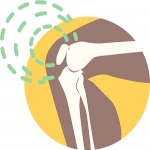ACL: Anterior Cruciate Ligament Tear, Part 1

Chicago Bulls’ superstar Derrick Rose was recently quoted in USA Today regarding his knee ACL tear he sustained not too long ago.
“I couldn’t believe it. That’s the closest thing to death I’ve got to right there, where it just seemed like the wind and everything was taken.”
If you have an athletic and active lifestyle, it can be devastating to hear that you have an Anterior Cruciate Ligament (ACL) tear. The stories are all over the press, “He has an ACL tear, out for the season”.
This month we will write a series of blog posts regarding treatment options, examination and diagnostic tests, surgery decisions, and rehabilitation information for ACL tears. We’ll also share with you patient testimonials and host a Q & A session with our KCBJ physician’s that perform ACL reconstructions.
Now, to learn a little more about ACL’s and ACL tears.
So, What is the ACL?
First let’s do a quick overview of the anatomy of the knee.
There are three bones that make up the knee joint. The thighbone (femur), the lower leg bone (tibia) and the kneecap (patella). In between the bones is another important structure called the meniscus. The medial and lateral menisci are made of soft cartilage that cushions the knee and helps it absorb shock during motion.
Your bones are connected by ligaments. There are four major ligaments in the knee to help with knee stability, or making sure that your knee doesn’t “give way.”
Two of these ligaments are called the medial and lateral collateral ligaments. They are located on the inner and outer sides of the knee. The other two ligaments are found inside the knee joint and are called the anterior and posterior cruciate ligaments. They form an “X” in the middle of the knee, with the ACL located in front. This ligament functions to prevent the tibia from sliding out in front of the femur as well as providing stability with rotation.
The Injury
The ACL can be injured in several ways with, or without contact. Some of these forms of injury include:
- decelerating when running
- changing directions rapidly
- landing incorrectly
- stopping suddenly
- direct contact or collision

When you injure your ACL, you might hear a “popping” noise, two pops in a row or feel your knee “give out”.
In that same USA Today Article, Derrick Rose comments on the moment of injury: “ I remember jumping in the air and coming back down, and just that popping sound.”
It is also not uncommon to have pain and swelling after the injury, a feeling of instability, weakness in the thigh muscle, a loss of motion and/or tenderness along the joint line.
Our next post will discuss physical examination and diagnostic testing to determine an ACL tear. Stay tuned the rest of this month to find out more about our featured problem of the month!

